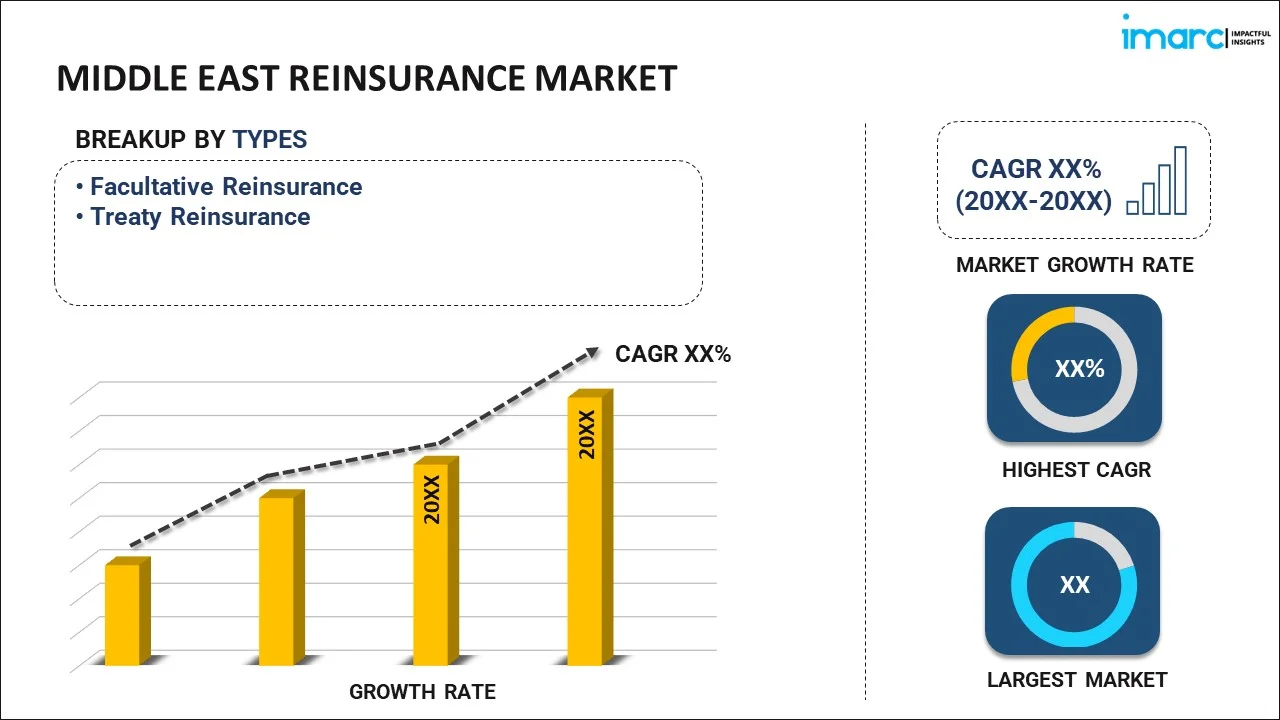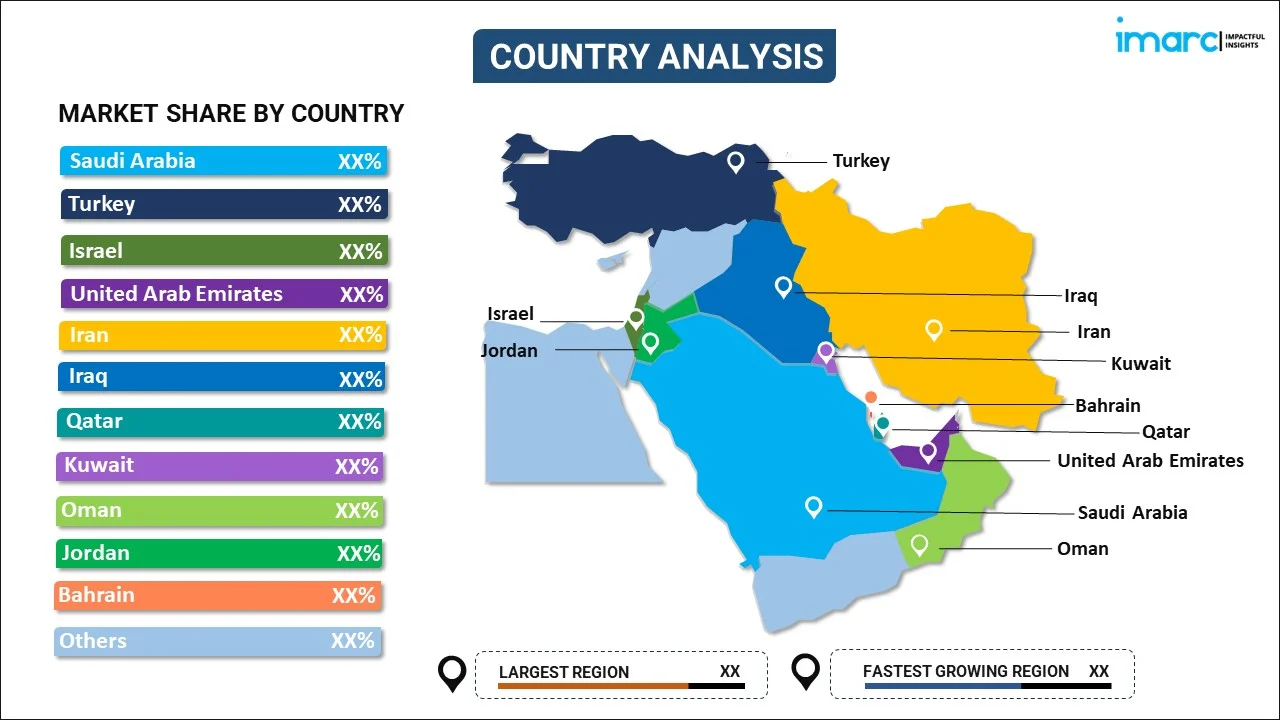
Middle East Reinsurance Market Report by Type (Facultative Reinsurance, Treaty Reinsurance), Mode (Online, Offline), Distribution Channel (Direct Writing, Broker), Application (Property and Casualty Reinsurance, Life and Health Reinsurance), and Country 2025-2033
Market Overview:
Middle East reinsurance market size reached USD 25,716.3 Million in 2024. Looking forward, IMARC Group expects the market to reach USD 34,049.7 Million by 2033, exhibiting a growth rate (CAGR) of 3.17% during 2025-2033. The growing replacement of traditional indemnity-based insurance models by parametric solutions that offer faster claims settlements, increasing frequency and severity of natural catastrophes, and rising integration of artificial intelligence (AI) for streamlining underwriting processes represent some of the key factors driving the market.
|
Report Attribute
|
Key Statistics
|
|---|---|
|
Base Year
|
2024
|
|
Forecast Years
|
2025-2033
|
|
Historical Years
|
2019-2024
|
| Market Size in 2024 | USD 25,716.3 Million |
| Market Forecast in 2033 | USD 34,049.7 Million |
| Market Growth Rate 2025-2033 | 3.17% |
Reinsurance is a risk management strategy employed by insurance companies to mitigate their exposure to large financial losses. It comprises proportional reinsurance, wherein the ceding company and the reinsurer share the premiums and losses in agreed-upon proportions. It also consists of non-proportional reinsurance, which provides coverage for losses exceeding a specified limit. It includes treaty reinsurance that is a long-term agreement between the ceding company and the reinsurer to cover a specific class of business. It encompasses facultative reinsurance, wherein the ceding company and the reinsurer assess individual risks, and the reinsurer has the option to accept or decline each risk presented. Reinsurance helps maintain the financial stability of insurance companies by preventing them from bearing the full brunt of large and unexpected losses. It plays a crucial role in managing and diversifying risks, allowing insurers to operate more efficiently and with greater confidence. It enables insurers to underwrite larger policies and enter new markets that they might otherwise find too risky. Reinsurance provides additional capacity to write more policies than a company might be able to handle on its own. It also reduces the financial burden on the ceding company as the cost of claims is shared between the ceding company and the reinsurer.
Middle East Reinsurance Market Trends:
At present, the increasing frequency and severity of natural catastrophes, compelling reinsurers to revisit their risk models and develop innovative risk management solutions, represents one of the crucial factors impelling the growth of the market in the Middle East. This trend is also encouraging reinsurers to collaborate with scientific institutions, meteorological agencies, and technology firms to enhance their predictive capabilities, enabling more accurate risk assessment and pricing strategies. Besides this, the rising integration of artificial intelligence (AI) in reinsurance services for streamlining underwriting processes, claims management, and risk assessment is contributing to the market growth in the region. Reinsurers are also leveraging blockchain technologies for enhancing transparency, reducing fraud, and optimizing the efficiency of reinsurance transactions. In addition, the growing digitization of various business processes is elevating the occurrence of innumerable non-traditional risks and encouraging reinsurers to develop specialized coverages for emerging risks and expanding their expertise in areas, such as cyber insurance. Apart from this, the increasing replacement of traditional indemnity-based insurance models by parametric solutions that offer faster claims settlements based on predefined triggers due to the rising need for more efficient and responsive risk transfer mechanisms is supporting the market growth. Additionally, regulatory bodies are increasingly emphasizing the importance of robust risk management frameworks and capital adequacy. Moreover, key market players are incorporating sustainability principles into their business strategies, with a focus on responsible underwriting practices and investments in green and socially responsible initiatives.
Middle East Reinsurance Market Segmentation:
IMARC Group provides an analysis of the key trends in each segment of the market, along with forecasts at the regional and country levels for 2025-2033. Our report has categorized the market based on type, mode, distribution channel, and application.
Type Insights:

- Facultative Reinsurance
- Treaty Reinsurance
- Proportional Reinsurance
- Non-proportional Reinsurance
The report has provided a detailed breakup and analysis of the market based on the type. This includes facultative reinsurance and treaty reinsurance (proportional reinsurance and non-proportional reinsurance).
Mode Insights:
- Online
- Offline
A detailed breakup and analysis of the market based on the mode have also been provided in the report. This includes online and offline.
Distribution Channel Insights:
- Direct Writing
- Broker
The report has provided a detailed breakup and analysis of the market based on the distribution channel. This includes direct writing and broker.
Application Insights:
- Property and Casualty Reinsurance
- Life and Health Reinsurance
- Disease Insurance
- Medical Insurance
A detailed breakup and analysis of the market based on the application have also been provided in the report. This includes property and casualty reinsurance and life and health reinsurance (disease insurance and medical insurance).
Country Insights:

- Saudi Arabia
- Turkey
- Israel
- United Arab Emirates
- Iran
- Iraq
- Qatar
- Kuwait
- Oman
- Jordan
- Bahrain
- Others
The report has also provided a comprehensive analysis of all the major regional markets, which include Saudi Arabia, Turkey, Israel, United Arab Emirates, Iran, Iraq, Qatar, Kuwait, Oman, Jordan, Bahrain, and Others.
Competitive Landscape:
The market research report has also provided a comprehensive analysis of the competitive landscape in the market. Competitive analysis such as market structure, key player positioning, top winning strategies, competitive dashboard, and company evaluation quadrant has been covered in the report. Also, detailed profiles of all major companies have been provided.
Middle East Reinsurance Market Report Coverage:
| Report Features | Details |
|---|---|
| Base Year of the Analysis | 2024 |
| Historical Period | 2019-2024 |
| Forecast Period | 2025-2033 |
| Units | Million USD |
| Scope of the Report | Exploration of Historical and Forecast Trends, Industry Catalysts and Challenges, Segment-Wise Historical and Predictive Market Assessment:
|
| Types Covered |
|
| Modes Covered | Online, Offline |
| Distribution Channels Covered | Direct Writing, Broker |
| Applications Covered |
|
| Countries Covered | Saudi Arabia, Turkey, Israel, United Arab Emirates, Iran, Iraq, Qatar, Kuwait, Oman, Jordan, Bahrain, Others |
| Customization Scope | 10% Free Customization |
| Post-Sale Analyst Support | 10-12 Weeks |
| Delivery Format | PDF and Excel through Email (We can also provide the editable version of the report in PPT/Word format on special request) |
Key Questions Answered in This Report:
- How has the Middle East reinsurance market performed so far and how will it perform in the coming years?
- What has been the impact of COVID-19 on the Middle East reinsurance market?
- What is the breakup of the Middle East reinsurance market on the basis of type?
- What is the breakup of the Middle East reinsurance market on the basis of mode?
- What is the breakup of the Middle East reinsurance market on the basis of distribution channel?
- What is the breakup of the Middle East reinsurance market on the basis of application?
- What are the various stages in the value chain of the Middle East reinsurance market?
- What are the key driving factors and challenges in the Middle East reinsurance?
- What is the structure of the Middle East reinsurance market and who are the key players?
- What is the degree of competition in the Middle East reinsurance market?
Key Benefits for Stakeholders:
- IMARC’s industry report offers a comprehensive quantitative analysis of various market segments, historical and current market trends, market forecasts, and dynamics of the Middle East reinsurance market from 2019-2033.
- The research report provides the latest information on the market drivers, challenges, and opportunities in the Middle East reinsurance market.
- Porter's five forces analysis assist stakeholders in assessing the impact of new entrants, competitive rivalry, supplier power, buyer power, and the threat of substitution. It helps stakeholders to analyze the level of competition within the Middle East reinsurance industry and its attractiveness.
- Competitive landscape allows stakeholders to understand their competitive environment and provides an insight into the current positions of key players in the market.
Need more help?
- Speak to our experienced analysts for insights on the current market scenarios.
- Include additional segments and countries to customize the report as per your requirement.
- Gain an unparalleled competitive advantage in your domain by understanding how to utilize the report and positively impacting your operations and revenue.
- For further assistance, please connect with our analysts.
 Request Customization
Request Customization
 Speak to an Analyst
Speak to an Analyst
 Request Brochure
Request Brochure
 Inquire Before Buying
Inquire Before Buying




.webp)




.webp)












